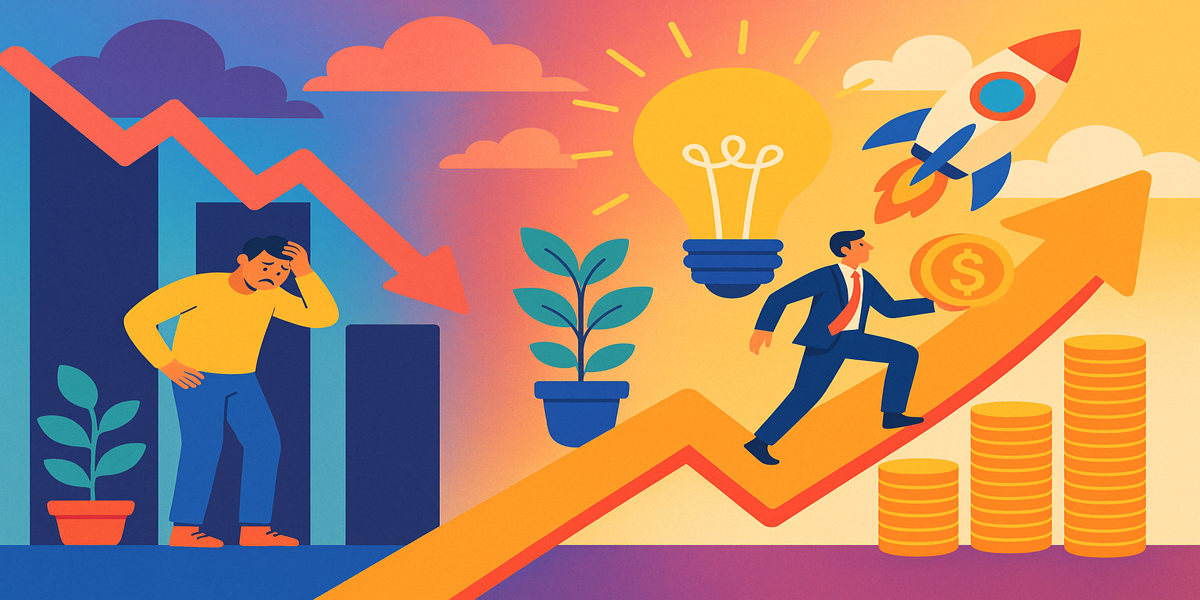The world economy in 2025 feels like it’s holding its breath. After a period of uncertainty, inflation moderation and surprising stock market gains are hinting at cautious optimism. At the same time, a powerful mix of AI disruption, sustainability priorities, and evolving investor behavior is quietly rewriting the rules of innovation.
So, what’s really going on- and what does it mean for new products, startups, and those leading innovation?
The Economy: Stable but Watchful
Global growth has slowed, but not stalled. Most forecasts hover around 2- 2.5% for the year, and while a full-blown recession hasn’t materialized, the mood remains conservative. Central banks are holding rates steady, watching inflation closely. Markets are responding with a mix of resilience and realism- tech stocks are thriving, while industrials and real estate remain cautious.
Key takeaways:
- Interest rates are stabilizing, but remain above pre-pandemic levels.
- Consumer confidence is rising slowly- particularly in the U.S. and parts of Europe.
- Public markets are strong, with the S&P 500 and Nasdaq hitting all-time highs.
Emerging Trends Fueling Change
1. AI as an Innovation Engine
Artificial intelligence is no longer just a buzzword- it’s deeply embedded in product strategies. From healthcare to logistics, companies are building intelligent features into everything. What used to take months of engineering can now be prototyped in days with the help of generative AI.
2. Retail Investors Are Growing Up
Retail investors- especially Gen Z and millennials- are taking a more strategic, long-term view. Platforms like Robinhood, eToro, and Freetrade are seeing rising activity not just in meme stocks, but in ETFs, green funds, and private market access. Investing is becoming a lifestyle, not a gamble.
3. Sustainability Drives New Markets
From energy-efficient products to carbon marketplaces, sustainability is not optional anymore. Governments are reinforcing this with regulations, but the bigger driver is consumer expectation. Companies with circular business models and climate-conscious supply chains are gaining ground- fast.
4. Private Capital Reshapes Innovation
While venture capital cooled briefly in 2023-2024, 2025 is seeing renewed interest in early-stage deals- especially in climate tech, AI infrastructure, and healthtech. Private equity is increasingly entering the innovation space too, funding product rollouts and tech modernization.
What This Means for Innovation & Product Development
We’re witnessing a shift in how products are imagined and built. The combination of AI, capital accessibility, and consumer shifts is redefining the product development lifecycle:
- Faster Prototyping: With AI-assisted tools, teams can develop MVPs in a fraction of the time.
- Smarter Funding: Founders are aligning more closely with investor theses- climate impact, AI scalability, or inclusive technology.
- Purpose-Driven Design: Products are expected to reflect values, not just functionality. Accessibility, sustainability, and privacy are part of product-market fit now.
Are People Still Investing?
Yes- but differently.
Investors are more selective and more thematic. They’re still putting money into innovation, but they’re asking smarter questions. Where’s the moat? What’s the carbon footprint? Is this solving a real problem- or just chasing hype?
What’s rising:
- AI infrastructure and tools
- Climate tech and green energy
- Alternative assets and private equity
- Financial products for retail investors
What’s struggling:
- Speculative crypto
- Consumer products without a sustainability story
- Startups with unclear monetization paths
Final Thoughts
2025 is not a boom year, but it’s not a bust either. It’s a strategic year- a time when thoughtful innovation, mission-aligned investing, and real-world problem solving are what succeed.
If you’re building something new, the opportunity is real. But the bar is higher. People want smarter products, cleaner solutions, and more transparent value. And for those ready to rise to that challenge- the economic landscape may be more fertile than it seems.
To navigate this shifting landscape with clarity and control, tools like IPMP help teams prioritize what matters, invest wisely, and innovate with confidence.




